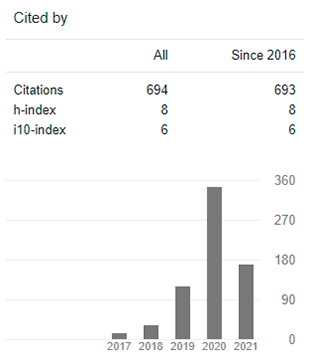Morphosyntactic errors in learning English as a foreign language: The context of university students
Errores morfosintácticos en el aprendizaje del inglés como lengua extranjera: El contexto de estudiantes universitarios
DOI:
https://doi.org/10.29394/Scientific.issn.2542-2987.2024.9.31.2.46-67Keywords:
morphosyntactic errors, written compositions, instruments, codes, error analysisAbstract
The objective of this research is to identify the most common morphosyntactic errors in the learning of English as a foreign language in the written production of 36 A1 level EFL students from a public university in Cotopaxi. Some authors agree that the most common morphosyntactic errors in texts written by students are word omission, spelling, article usage, double consonant usage, incorrect verb tense, incorrect word choice, punctuation, preposition, incorrect word form, agreement, pronouns, translated words, simple words, lexicon, style, number and order of adjectives (Suleman, Altayib and Muhammad, 2018); (Khatter, 2019); (Cordero and Martin, 2020); and (Soto, Vargas, Cajamarca and Escobar, 2020). To achieve the objective, the error analysis method was used. Two types of written compositions were used as data collection instruments, which were obtained in the last two weeks of July 2022. As results, the most common errors were Punctuation, Spelling, Capitalization and Sentence Structure, which belong to mechanical and grammatical errors. It is concluded that writing in English is quite challenging for students, as they need to be in constant contact with the English language. In this sense, if written errors are corrected early, students will have better written communication.
Downloads
References
Abid, R. (2016). Mother-Tongue Interference in the Acquisition of English Articles by L1 Arabic Students. Journal of Education and Practice, 7(3), 1-4, e-ISSN: 2222-288X. China: International Knowwledge Sharing Platform.
Al-Ghabra, I., & Najim, A. (2019a,b). Analyzing Errors Committed in Paragraph Writing by Undergraduates. Journal of Language Teaching and Research, 10(2), 264-270, e-ISSN: 1798-4769. Retrieved from: http://dx.doi.org/10.17507/jltr.1002.07
Alghazo, K. & Alshraideh, M. (2020). Grammatical Errors Found in English Writing: A Study from Al-Hussein Bin Talal University. International Education Studies, 13(9), 1-9, e-ISSN: 1913-9039. Retrieved from: https://doi.org/10.5539/ies.v13n9p1
Amara, N. (2015a,b,c). Errors correction in foreign language teaching. The Online Journal of New Horizons in Education, 5(3), 58-68, e-ISSN: 2146-7374. Turkey: Sakarya: Sakarya Üniversitesi Eğitim Fakültesi.
Aziz, Z., Fitriani, S., & Amalina, Z. (2020). Linguistic errors made by Islamic university EFL students. IJAL. Indonesian Journal of Applied Linguistics, 9(3), 733-745, e-ISSN: 2502-6747. Retrieved from: https://doi.org/10.17509/ijal.v9i3.23224
Bakan, H., Cepanec, V., Dvorski, M., Janeš, J., Milanović, I., Novosel, A., … Verveger, I. (2020). The Importance of Error Correction in Foreign Language Learning. Patchwork Student Journal, (4), 7-26. Croacia: Portal de revistas científicas y profesionales croatas - Hrčak.
Cifuentes-Rojas, M., Contreras-Jordán, R., & Beltrán-Moreno, M. (2019a,b). The Development of the English Language Teaching in the High Schools of Ecuador during the last two decades. Polo del Conocimiento: Revista científico - profesional, 4(10), 89-98, e-ISSN: 2550-682X. Ecuador: Imprenta y Casa Editora “Coni”.
Cordero, D., & Martin, V. (2020a,b,c,d). Errores léxicos en la producción escrita de estudiantes de ILE. Letras, (68), 175-198, e-ISSN: 2215-4094. Recuperado de: http://dx.doi.org/10.15359/rl.2-68.7
Dissington, P. (2018). Addressing the Problem of Negative Lexical Transfer Errors in Chilean University Students. Profile: Issues in Teachers' Professional Development, 20(1), 25-40, e-ISSN: 2256-5760. Retrieved from: https://doi.org/10.15446/profile.v20n1.64911
Dulay, H., Burt, M., & Krashen, S. (1982). Language Two. Reino Unido: Oxford University Press.
Escudero, G., Cutiopala, D., Caisaguano, J., & Gallegos, L. (2020). A comprehensible overview of EFL students’ drawbacks to produce oral communication. Revista Espacios, 41(18), 30-43, e-ISSN: 0798-1015. Venezuela: Grupo Editorial Espacios GEES, 2021, C.A.
Espinar, C. (2021). Enhancing English in Ecuador: Exploring Korean English Educational Policy Innovations. Revista Iberoamericana de la Educación, 4(3), 52-77, e-ISSN: 2737-632X. Quito, Ecuador: Instituto Tecnológico Superior Corporativo Edwards Deming.
Giyatmi, G. (2019a,b). Morphology for English Language Teaching. Proceeding ICoLLiT. The 2nd International Conference on Language, Literature and Teaching, 33-41, e-ISSN: 2549-5607. Indonesia: International Conference on Language, Literature and Teaching.
Hidayati, K. (2018). Teaching Writing to EFL Learners: An Investigation of Challenges Confronted by Indonesian Teachers. Journal of the Association for Arabic and English, 4(1), 21-31, e-ISSN: 2549-9017. Indonesia: Kendari Sulawesi Tenggara: UPT Pengembangan Bahasa IAIN Kendari.
Isnaeni, M., & Datang, F. (2017). Error Analysis of Using Punctuation in Narrative Text. ELT- Lectura: Jurnal Pendidikan, 4(1), 48-55, e-ISSN: 2550-0724. Indonesia: Pekanbaru: Tim Jurnal ELT-Lectura FKIP-Unilak.
Johansson, S. (2008a,b). Contrastive analysis and learner language: A corpus-based approach. Noruega: University of Oslo - UiO.
Jumayeva, M. (2022). The importance of learning english as a foreign language. Science and Innovation in the Education System, 1(7), 35-37. Rusia: International scientific-online conference.
Khatter, S. (2019a,b,c,d,e,f,g,h). An Analysis of the Most Common Essay Writing Errors among EFL Saudi Female Learners (Majmaah University). Arab World English Journal, 10(3), 364-381, e-ISSN: 2229-9327. Retrieved from: https://dx.doi.org/10.24093/awej/vol10no3.26
Kusnadi, D. (2018a,b). Spelling Error In The Writing English Of Second Years at SMP PGRI Pekanbaru. Other tesis. Indonesia: Universitas Islam Riau.
Li, Z., Parnow, K., & Zhao, H. (2022). Incorporating rich syntax information in Grammatical Error Correction. Information Processing & Management, 59(3), e102891, e-ISSN: 0306-4573. Retrieved from: https://doi.org/10.1016/j.ipm.2022.102891
Manirakiza, E., Mugirase, G., & Hakizimana, I. (2021a,b,c). Reflecting on the Nature and Causes of Errors in Second Language Learning and their Classroom Implications. European Journal of Teaching and Education 3(4), 18-28, e-ISSN: 2669-0667. Retrieved from: https://doi.org/10.33422/ejte.v3i4.549
Maolida, E., & Hidayat, M. (2021). Writing Errors Based on Surface Structure Taxonomy: A Case of Indonesian EFL Students’ Personal Letters. Indonesia: Proceeding International Conference on Education of Suryakancana.
Muftah, M. (2023a,b). Error Analysis in Second Language Acquisition (SLA): Types and Frequencies of Grammatical Errors of Simple Present and Past Tense in the Elicited Written Production Task of Arab EFL Undergraduate Learners. Colombian Applied Linguistics Journal, 25(1), 42-56, e-ISSN: 2248-7085. Retrieved from: https://doi.org/10.14483/22487085.19202
Muñoz, E. (2017). Ecuadorian public high school students´ errors in EFL writing skills. Ecuador: Universidad Técnica Particular de Loja.
Pathan, A. (2021). The Most Frequent Capitalization Errors Made by the EFL Learners at Undergraduate Level: An Investigation. Scholars International Journal of Linguistics and Literature, 4(3), 65-72, e-ISSN: 2617-3468. Retrieved from: https://doi.org/10.36348/sijll.2021.v04i03.001
Ramadan, S. (2015a,b). Morphological Errors Made By Jordanian University Students. Romanian Journal of English Studies, 12, 40-49, e-ISSN: 2286-0428. Retrieved from: https://doi.org/10.1515/rjes-2015-0006
Rezai, M., & Davarpanah, F. (2019a,b). The Study of Formal and Semantic Errors of Lexis by Persian EFL Learners. International Scholarly and Scientific Research & Innovation 13(1), 41-47, e-ISSN: 1307-6892. United States: World Academy of Science, Engineering and Technology.
Salehi, M., & Bahrami, A. (2018a,b). An error analysis of journal papers written by Persian authors. Cogent Arts & Humanities, 5(1), 1-16. Retrieved from: https://doi.org/10.1080/23311983.2018.1537948
Sang, N., Thu, N., Chi, N., & Luan, N. (2022a,b). An analysis of sentence structure errors in essay writings committed by sophomores at Can Tho University, Vietnam. European Journal of Applied Linguistics Studies, 5(2), 84-98, e-ISSN: 2602-0254. Retrieved from: http://dx.doi.org/10.46827/ejals.v5i2.372
Sermsook, K., Liamnimitr, J., & Pochakorn, R. (2017). An Analysis of Errors in Written English Sentences: A Case Study of Thai EFL Students. English Language Teaching, 10(3), 101-110, e-ISSN: 1916-4750. Retrieved from: http://dx.doi.org/10.5539/elt.v10n3p101
Songxaba, S., & Sincuba, L. (2019a,b,c). The Effect of Social Media on English Second Language Essay Writing with Special Reference to WhatsApp. Reading & Writing: Journal of the Reading Association of South Africa, 10(1), 1-7, e-ISSN: 2079-8245. Retrieved from: https://eric.ed.gov/?id=EJ1224060
Soto, S., Vargas, E., Cajamarca, C., & Escobar, M. (2020a,b,c,d,e,f). The most common errors within the written discourse of EFL beginners at Ecuadorian universities. Machala, Ecuador: Editorial UTMACH.
Suleman, M., Altayib, A., & Muhammad, K. (2018a,b,c,d,e). Analysis of Syntactic Errors in English Writing: A Case Study of Jazan University Preparatory Year Students. Journal of Education and Practice, 9(11), 113-120, e-ISSN: 2222-288X. China: International Knowwledge Sharing Platform.
Tajeddin, Z., & Tabatabaeian, M. (2017). Interface between Linguistic Noticing and Fossilization of Grammatical, Lexical, and Cohesive Features among Advanced EFL Learners. Applied Research on English Language, 6(1), 23-42, e-ISSN: 2322-5343. Retrieved from: https://doi.org/10.22108/are.2017.21324
Torres, R. (2020). Code-Switching Strategies: Prosody and Syntax. Frontiers in Psychology 11, 1-15, e-ISSN: 1664-1078. Retrieved from: https://doi.org/10.3389/fpsyg.2020.02130
Yuliah, S., Widiastuti, A., & Resta, G. (2019a,b). The Grammatical and Mechanical Errors of Students in Essay Writing. Jurnal Bahasa Inggris Terapan, 5(2), 61-75, e-ISSN: 2721-2890. Indonesia: Bandung: Politeknik Negeri Bandung.
Published
How to Cite
Issue
Section
License
Copyright (c) 2024 INDTEC, C.A.

This work is licensed under a Creative Commons Attribution-NonCommercial-ShareAlike 4.0 International License.
The content of the journals of this site, are under a Creative Commons Attribution-Noncommercial-Share Alike 4.0 International License.













